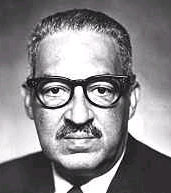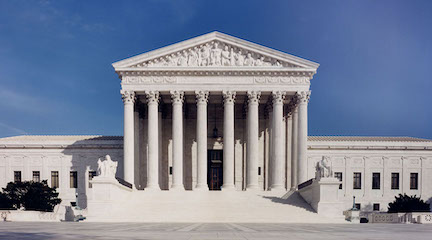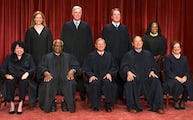The Vacancy

The Justice Thurgood Marshall Press Conference, July 7, 1991
Reporter: Why did you resign?
Marshall: I didn't resign; I retired!
Thurgood Marshall
Leaving the Court
Retirement, Resignation or Death
There are essentially four ways for justices to leave the Court: retirement, resignation, removal through the impeachment process, or death.
As Justice Marshall vigorously pointed out to a reporter, retirement and resignation are not the same. Before 1869, there were no retirement benefits,
hence no retirement. Resignation or death were the two ways to leave the Court.
A retirement provision in 1869 permitted justices 70 years of age or over and with at least 10 years on the Court to leave the Court at their current pay,
although that amount was susceptible to change, including a decrease. In the aftermath of the failed 1937 Court packing plan, a more attractive option
permitted these "70/10" retiring justices to remain "on call" as Article 3 judges who, according to the Constitution, may not have their salaries diminished
"during their continuance in office." Effectively, this permitted retirement at full pay.
Methods of Departure
Resignations now occur when the sitting justice fails to meet the retirement criteria or chooses to forego the Article 3 retirement privileges.
Below are data on how justices have left the Court.
| Year of Departure | Death | Resignation | Retirement | Removal |
| 1789 - 1868 | 22 | 9 | 0 | 0 |
| 1869 - 1899 | 10 | 1 | 6 | 0 |
| 1900 - 1936 | 9 | 2 | 8 | 0 |
| 1937 - 2021 |
10 | 4 | 27 | 0 |
| Totals | 51 | 16 | 41 | 0 |
Note: The total number of departures (108) is one
more than the total number of people who have left the Court (107) because
Charles Evans Hughes served at two different times, resigning in 1916
to run for the presidency and then returning to the Court in 1930 and
retiring in 1941.
Note 2: These numbers do not reflect the interim appointment
and service of John Rutledge during his second time on the Court. Having
resigned in 1791 from his initial appointment to the Court, Rutledge
subsequently was given a recess appointment by George Washington and
actually presided as Chief Justice in 1795 only to be rejected by the
Senate when it returned to session and Rutledge's name was formally
submitted for confirmation.
The Significance of Vacancies
On average, a vacancy occurs about every two years, at least since
1937 when an enhanced retirement option for the justices was established. But vacancies do not occur with such regularity.
Eleven years elapsed between vacancies created by the Blackmun retirement (1994) and Rehnquist death (2005), the longest
period since the stretch between 1811 when Justice Chase
died and 1823 with the death of Justice Livingston. The second longest stretch without a vacancy
in the twentieth century occurred over the six-year period of 1975 to 1981, completely encompassing
the administration of President Carter, the only president in the 20th century
to serve a full term in office without making an appointment
to the Court. Only
two presidents served during
the record length of time between the vacancies of 1811 and 1823 (Madison
and Monroe) but both were able to name justices to the Court. On the other hand, President Nixon and Trump were gifted
with three vacancies in their first term of office. Nixon fumbled the conservative ball, appointing Blackmun and Powell, neither of
whom turned out to be the conservative justices he expected. As the influence of the conservative Federalist Society, established in 1982,
has grown, the appointment of more bona fide conservative jurists has been assured.
President George W. Bush and the political right were hoping for vacancies among the more liberal four justices on the Court.
Bush was able to replace the conservative centrist O'Connor with a more conservative Alito, but he had to settle for replacing
Chief Justice Rehnquist with John Roberts, all in all not the kind of change conservatives hoped for. President Obama was able
to replace two members of the liberal bloc with other liberals, but he was denied the opportunity to appoint his third justice
to the Court, the Republican Senate refusing to consider his nomination of Merrick Garland to replace the departed Antonin Scalia,
an action which could have replenished, for a while, the liberal bloc on the Court.
The Ginsburg vacancy was a god-send for the political right. While achieving the
Republican goal of a conservative majority on the Court
with the appointment of Kavanaugh to replace the swing justice that was Kennedy, certain fissures in that bloc remained. Justice
Gorsuch proved faithful to his textualism, more so even than Scalia, and that meant joining the liberal bloc on a few occasions.
Chief Justice Roberts claimed stare decisis when joining the liberal bloc in a Louisiana abortion rights case, and his pivotal
votes to uphold the Affordable Care Act and shut down President Trump's effort to end DACA dismayed conservatives. With an
opportunity to move the Court even more solidly to the right, Republicans pounced on the nomination, even while Ginsburg laid in
state at the Supreme Court. Had she been able to anticipate what would happen, she surely would have retired during Obama's
presidency. It's hard for some to leave the Court. William O. Douglas, the longest serving justice, hoped to outlast the Nixon
administration. And while he did outlast Nixon, he died during President Ford's tenure, a man who had led an impeachment effort
against Douglas just a few years prior. Douglas's replacement, however, would turn out, unexpectedly for conservatives, to be a
leader of the liberal bloc on the Court (John Paul Stevens). That did not happen with Ginsburg.
Scalia certainly had no intention of leaving the Court in 2016 despite his almost 30 years of service and his 80th birthday
approaching. He was only the second justice to die while serving on the Court in the past 60 years, Chief Justice Rehnquist having
died in 2005. The Scalia vacancy presented President Trump with an appointment upon arriving in office. The retirement of Justice Kennedy,
just short of his 82nd birthday, provided a second opportunity for Trump to shape the Court in only his second year in office.
Kennedy's departure was the most
significant vacancy to occur since that of Justice Thurgood Marshall in 1991. Marshall's replacement by Clarence Thomas created a more consistent
conservative output from the Court. Kennedy's departure has removed the only justice who could not be placed within the conservative
or the liberal bloc of justices more than 75% of the time. His replacement by Brett Kavanaugh established a consistent majority conservative
bloc for the first time in the Court's modern era (post-1952). The replacement of Ginsburg with Barrett, however, was transformative,
resulting in the overturning of Roe v. Wade (1973) more expansive interpretations of the First and Second amendments. The conservative
bloc on the Court has signaled there is more to come, conceivably overturning previous opinions that, to their and way of thinking, were decided incorrectly.
The most recent change, Breyer with Jackson does not portend any significant change in visualizing the Court as having a conservative bloc of
six and a liberal bloc of three. The addition of a fourth woman and a young Black woman, however, will
surely have some impact on the Court. While hardly as stark as replacing Ginsburg with Barrett, Jackson will no doubt perceive some matters
differently than Breyer would.
Who's Next?
What about the current justices? All seem reasonably healthy; all seem dedicated to the job; the workload having become more
manageable over the past twenty years. It's good work if you can get it. The oldest is Thomas, who turns 74 in 2022. As a conservative
stalwart hoping now to see some of his
dissents turn into majority opinions with a solid conservative Court, Thomas has no desire to have his replacement filled by Democrats.
He may also anticipate being the justice with the longest service in Court history. He will eclipse William O. Douglas on May 20, 2028,
just short of his 80th birthday.
The other "conservatives"
George W. Bush appointees, John Roberts (2005) and Samuel Alito (2006), are 68 and 72 years old in 2022. In the normal course of events, both
would be expected to serve past even a two-term Democratic presidency. President Trump, of course, was fortunate to appoint three justices:
Neil Gorsuch, Brett Kavanaugh, and Amy Comey Barrett, all in their 50s There is evey reason to assume that they will all serve for another 20 to 30 years
or more.
The "liberals"
Sonia Sotomayor, appointed by Obama in 2009, turns 68 in June of 2022. and Elena Kagan, appointed
by Obama in 2010, turns 62 in April of 2021. Both are apparently in good health, neither having evidenced any desire to retire in the foreseeable
future. Newly appointed Ketanji Brown Jackson is 52 in 2022.
Last updated: October 26, 2022. |



